
Push? Win? Lose? Learn how 0.25 and 0.75 goal lines really work.
Have you ever wondered what all these different goal lines actually mean?
You’ve seen bets like Over/Under 2.5, Over/Under 2.25, even Over/Under 2. But how can you bet on 2.75 goals – or 2.25? After all, there’s no such thing as half a goal – or a quarter of one. It sounds absurd… doesn’t it?
Don’t worry – you’re not alone.
In this article we’ll break down what each type of goal line really means. By the end, you’ll know exactly when your bet wins, loses, or sees your stake refunded – and you’ll never be confused again.
Dive deeper with our 👉 The Science of Football Predictions: Over Under ‘X’ Goals – a course, designed to give you the essential, fundamental knowledge necessary to understand odds calculation and the bookmaker’s market.
Betting on .5 Goals
One of the most common bet types is Over/Under .5 goals.
Of course, it’s impossible for half a goal to be scored in a match. The “.5” is simply used to make the outcome unambiguous – there can be no draw or refund. There are only two results: either over or under; and you either win or lose that bet.
For example, in an Over 2.5 goals bet:
- You win if three or more goals are scored in the match.
- You lose if the match ends with two or fewer.
Here’s a simple visual to explain it:
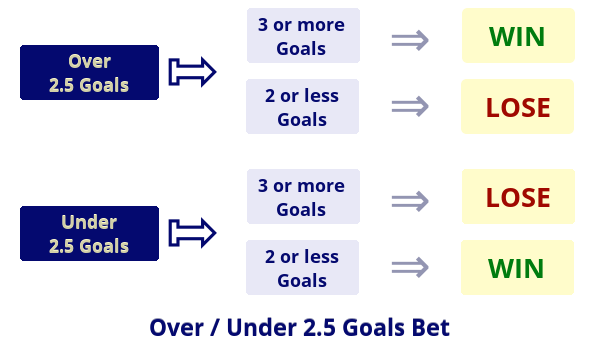
If you have difficulties understanding the concept, here’s another article on the .5 bet: A Brief Introduction to Over Under Goals Betting. It explains the .5 line in more detail.
Betting on Goal Lines with Whole Numbers
Bets on whole numbers are often referred to as Goal Lines or Asian Goal Lines. Strictly speaking this isn’t entirely accurate, because all Over/Under bets are technically goal lines – but we use the term here because it’s widely adopted by punters and bookmakers alike.
Whole-number goal lines are somewhat like Asian Handicap bets on the 1×2 result. As the name suggests, these bets include the possibility of a refund – in this case, when the number of goals scored matches the “goal line”
If the final score exactly equals the goal line, the bet results in a push, and your stake is refunded. If fewer goals are scored, the bet loses; if more goals are scored, it wins.
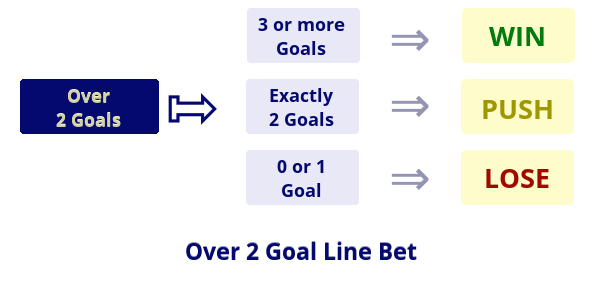
In the example above, a bet on Over 2 Goals results in:
- A push (refund) if exactly 2 goals are scored (e.g. 2–0, 1–1, 0–2),
- A win if 3 or more goals are scored,
- A loss if the game ends with fewer than 2 goals.
All other whole-number goal lines follow the same logic.
Betting on .75 or .25 Goals – Quarter-Lines Explained
When .5 goal bets are combined with Asian Goal Line bets, you get .25 and .75 goal lines. These are known as quarter-goal bets.
In such bets, your stake is split in half:
- Half your stake goes on the standard .5 line (e.g. Over 2.5).
- The other half goes on a whole-number Goal Line (e.g. Over 2.0).
These bets are usually shown as:
- Over 2.25 or Over 2, 2.5
- Over 2.75 or Over 2.5, 3
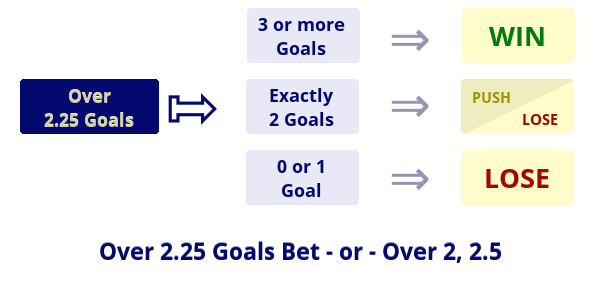
Let’s say you place a £20 bet on Over 2.25 (also written as Over 2, 2.5).
This means:
- £10 is placed on Over 2.0
- £10 is placed on Over 2.5
Here’s what happens based on the final score:
| Final Goals Scored | Outcome |
|---|---|
| 3 or more | Both bets win → stake returned with winnings from both bets. |
| Exactly 2 |
Over 2.0 is a push → £10 stake refunded Over 2.5 loses → £10 stake lost |
| 0 or 1 | Both bets lose → the entire £20 stake is lost |
The same applies to the .75 bets, as shown below:
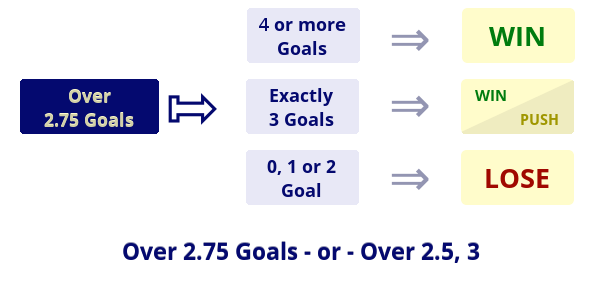
In this example, imagine placing a £20 bet on Over 2.75 (also written as Over 2.5, 3).
This means:
- £10 is placed on Over 2.5
- £10 is placed on Over 3.0
Here’s how it breaks down:
| Final Goals Scored | Outcome |
|---|---|
| 4 or more | Both bets win → stake returned with winnings from both bets. |
| Exactly 3 |
Over 3.0 is a push → £10 stake refunded Over 2.5 wins → £10 stake returned plus winnings. |
| 0, 1 or 2 | Both bets lose → the entire £20 stake is lost |
Quarter Lines: A Clever Trap in Disguise?
To be honest, I’d recommend keeping your hands off these bets – even if the idea of getting half your stake back may sound appealing.
Although they’re marketed as a single bet, quarter-goal lines are two separate bets rolled into one.
If you’re not comfortable with odds calculation and probability, these bets are exactly what bookmakers love. They can adjust the price freely, knowing most punters don’t grasp the underlying maths – and the mathematical edge stays firmly with them.
And remember: two bets bundled into one are, in effect, an accumulator.
Read why bookmakers absolutely love taking accumulator and multiple bets – and how the maths quietly works in their favour:
The silver lining? You’ll rarely be tempted, as these bets are not commonly offered by European bookmakers.
Here’s another diagram that demonstrates how split bets work:
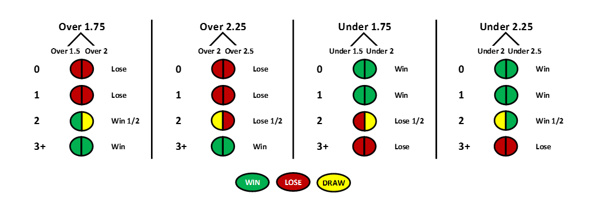
Goal Betting: The Ideal Starting Point for Profitable Betting
At the end of the day every punter’s aim should be the same: to bet for profit. Wouldn’t you agree?
Bookmakers certainly do. They make a living from betting by applying mathematics and probability. They analyse outcomes, calculate chances, and price their markets accordingly. And like any operator of a game of chance they ensure the mathematical edge is always on their side.
The punter who bets purely on gut feeling simply can’t compete.
Instinct, emotion, or memories of the last match will always be outmatched by mathematics.
However, Over/Under betting offers a good starting point. It’s one of the few markets where you can begin to understand the statistics behind the odds – simple enough to analyse, yet structured enough to teach the core principles of value, probability, and price logic.
If you can calculate what a fair price (odds) should be, then – and only then – can you identify bets worth taking.
📘 Explore our latest article: Betting Education Isn’t Dead: Soccerwidow’s Return to Form
Learn why we believe the future of betting lies in structured thinking, not blind luck.
This article was originally published in February 2017 and has been fully refurbished and updated on 30 June 2025.


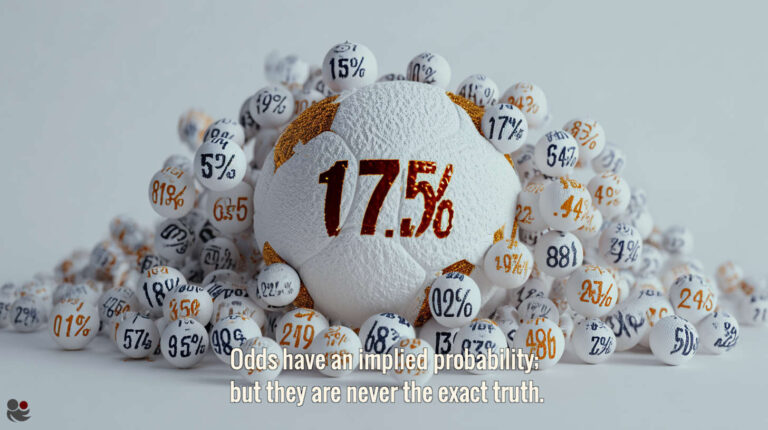




May I know what time do u manufacture 1*2 betting market course book?
It will take a while. Fingers crossed that I will find the time to start writing in March, but from the first sentence to the final product it’s going to be at least 6 months.
Hi Soccerwidow,
If you publish a book on the 1 x 2 betting market, will the maths covered be very different from the maths in the Fundamental of Sports Betting book? Once one has done this course and using the value calculator, is this a good basis for understanding the maths of 1 x 2 betting?
Hi Audiendi,
some of the maths covered in the OU course will have to be repeated such as deviations and odds ranges as these are the basics of understanding odds calculation and market price setting. I will extend on data analysis, and there will be a big chapter on Charts & Graphs, their interpretation and evaluation. Otherwise, I have not yet decided how deep I’ll go with mathematical explanations as they are becoming more and more complicated for ‘normal’ people to follow.
If you have successfully worked through the OU course, then it will be certainly a good basis for understanding the 1×2 course.